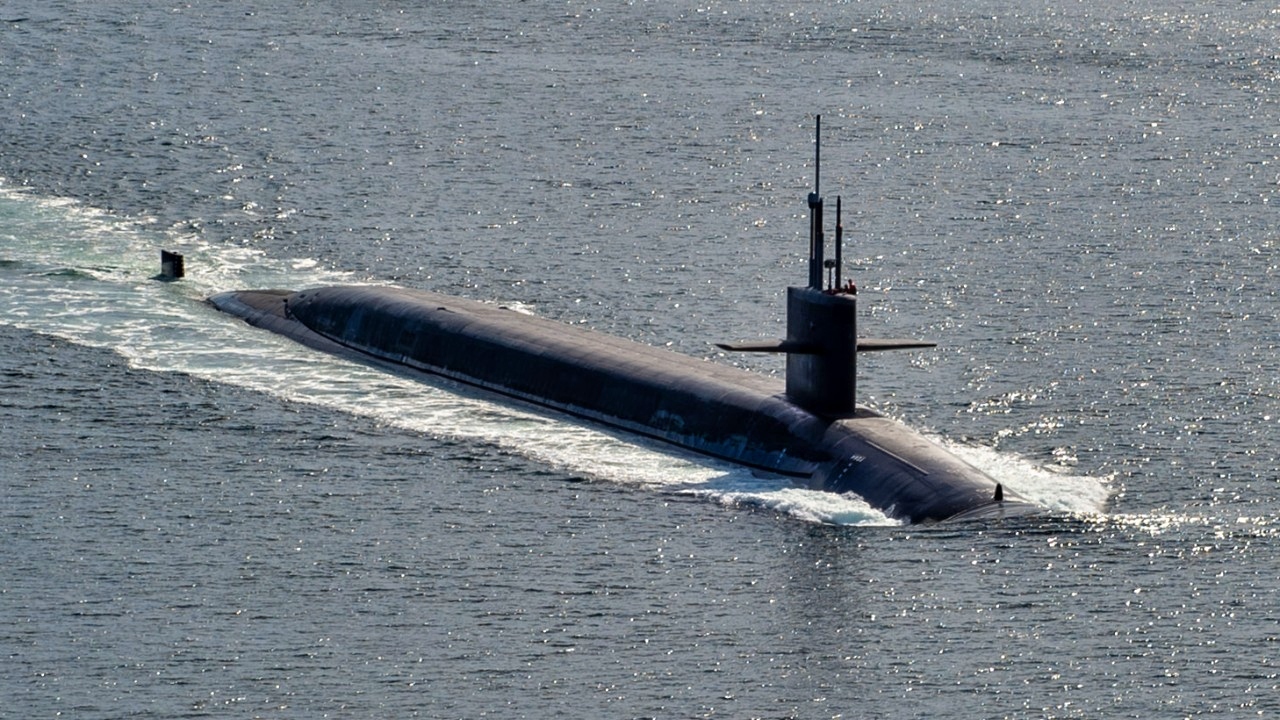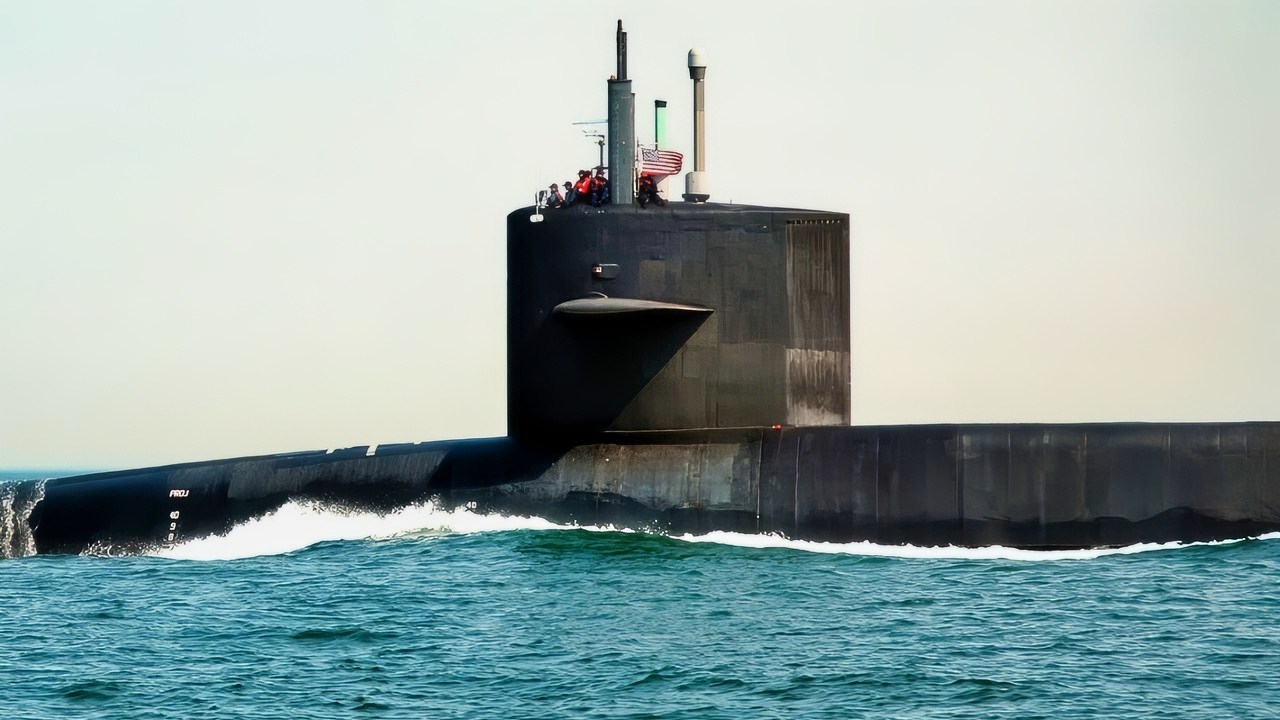Key Points and Summary – Roughly 15 years ago, the U.S. Navy surfaced three Ohio-class SSGN missile submarines in a warning to China. However powerful a message that was over a decade ago, the military balance between Washington and Beijing has shifted.
-The strategic landscape beneath the Indo-Pacific is changing, with China’s growing submarine fleet becoming increasingly capable and visible, challenging decades of U.S. undersea dominance.

Puget Sound Naval Shipyard, Wash. (Aug. 14, 2003) — Illustration of USS Ohio (SSGN 726) which is undergoing a conversion from a Ballistic Missile Submarine (SSBN) to a Guided Missile Submarine (SSGN) designation. Ohio has been out of service since Oct. 29, 2002 for conversion to SSGN at Puget Sound Naval Shipyard. Four Ohio-class strategic missile submarines, USS Ohio (SSBN 726), USS Michigan (SSBN 727) USS Florida (SSBN 728), and USS Georgia (SSBN 729) have been selected for transformation into a new platform, designated SSGN. The SSGNs will have the capability to support and launch up to 154 Tomahawk missiles, a significant increase in capacity compared to other platforms. The 22 missile tubes also will provide the capability to carry other payloads, such as unmanned underwater vehicles (UUVs), unmanned aerial vehicles (UAVs) and Special Forces equipment. This new platform will also have the capability to carry and support more than 66 Navy SEALs (Sea, Air and Land) and insert them clandestinely into potential conflict areas. U.S. Navy illustration. (RELEASED)
-China now operates a credible sea-based nuclear deterrent with its Type 094 SSBNs and is building the quieter, next-generation Type 096.
-Mirroring a famous 2010 U.S. show of force, China is now using its submarines for overt signaling.
-In response, the U.S. and its allies are also making their submarine presence more public through port calls and joint patrols, turning the traditionally “silent service” into a visible instrument of deterrence and reassurance.
Remember When 3 U.S. Ohio-Class SSGN Subs Surfaced at Once?
In June 2010, the USS Ohio (SSGN-726), the USS Michigan (SSGN-727), and the USS Florida (SSGN-728) surfaced simultaneously in three Indo-Pacific areas – the Subic Pay, the Bay of Pusan, and the Indian Ocean. The incident has long been recognized as a clear and deliberate signal from the United States Navy to Beijing that the U.S. still maintains control over the seas.
That moment matters in historical terms – it is, after all, an example of a global superpower threatening a near-peer adversary as it began its own naval build-up. But it’s also interesting now, some 15 years later, because the script has shifted somewhat. Today, it’s the People’s Liberation Army Navy (PLAN) that is both building credible sea-based nuclear deterrent forces while also increasingly using them for signaling.
All the while, the United States and its allies are recalibrating their own posture for a far more contested Indo-Pacific. Submarine port visits, joint patrols, and high-profile under-sea deployments now serve not just to deter China as they once did, but to reassure partners like Japan, South Korea, and the Philippines that American under-sea dominance remains credible.
China’s Expanding Sea-Based Deterrent
The significance of China’s submarine advances lies in the shift from latent capability, meaning that China was building the technology but did not have the undersea fleet it has now, to operational credibility.
Once the PLAN’s undersea assets were regarded as too easy to detect, too low in numbers, and regionally constrained – but today, China is beginning to field a fleet of increasingly capable submarines.

The Ohio-class ballistic-missile submarine USS Maine (SSBN 741) transits the Puget Sound during routine operations, March 18, 2025. Commander, Submarine Group (SUBGRU) 9, exercises administrative control authority for assigned submarine commands and units in the Pacific Northwest providing oversight for shipboard training, personnel, supply and material readiness of SSBNs and their crews. SUBGRU-9 is also responsible for nuclear submarines undergoing conversion or overhaul at Puget Sound Naval Shipyard in Bremerton. (U.S. Navy photo by Mass Communication Specialist 1st Class Ryan Riley)
The U.S. Department of Defense has described China’s Type 094 nuclear ballistic missile – a submarine that became operational around 2010 and began nuclear deterrence patrols in December 2015 – as China’s “first credible sea-based nuclear deterrent.” Beijing operates six such submarines armed with JL-2 missiles and, according to Russian sources, potentially JL-3 missiles that could reach American territories from Chinese shores. Refitting these submarines with more capable armament is just one part of China’s strategy, too.
A next-generation SSBN, known as the Type 096, is under construction.
The submarine is projected to be much larger, at around 20,000 tons submerged, and significantly quieter. The sub will feature advanced noise-reduction reportedly supported by Russian technology. And, the PLAN’s submarine fleet is projected to expand to around 65 units by 2025, and possibly 80 vessels or more by 2035.
And as China continues its naval build-up, there have been increasing examples of the Chinese Navy surfacing its vessels for largely the same reason the United States famously did in 2010.
In February 2025, the South China Morning Post reported that Type 094 boats have been conducting “near-continuous” patrols in the South China Sea, with the U.S. and its allies closely monitoring the vessels, implying far greater readiness than was seen only a decade ago.
And, in May 2025, the PLAN published new technical data publicly for one of its SSBNs – a form of signaling in itself, targeting domestic, regional, and global audiences.
China’s deterrent is no longer under construction – it is operational and growing in strength and numbers.
U.S. and Allied Response
With China’s undersea power growing, Washington and its partners cannot simply rely on secrecy or a technological edge alone; the gap, after all, is narrowing by the day.
They must, therefore, continue to make their presence visible – and the world is seeing it in the form of more overt port calls, allied submarine manoeuvers, and public signaling of America’s under-sea reach.

China Nuclear Submarine. Image Credit: Creative Commons.
For example, on September 24, 2025, the U.S. Navy’s USS Ohio surfaced at Subic Bay in the Philippines in a highly publicized event as part of the Seventh Fleet’s forward-deployed posture. In July 2025, Ohio moored at Brisbane alongside the submarine tender USS Frank Cable – the first time an Ohio-class SSGN visited Brisbane.
A U.S. Navy guided-missile submarine capable of carrying large missile loads made a rare, publicized port visit to the Philippines in late September 2025.
That same month, a map published by Newsweek showed U.S. nuclear-powered submarines maintaining a presence across the First, Second, and Third Island Chains in the Pacific.
What the world is seeing now is arguably an undersea form of the Cold War’s visible deterrence postures, and the implications are varied. First, the “silent service” is no longer entirely silent. Visibility has strategic value, and when adversaries see submarines surfacing, port-calling, or generating media attention, it complicates their own assumptions of having a stealth advantage.
Additionally, China’s maritime signaling suggests that the country is now confident in its abilities and that upcoming submarines will continue to narrow the gap with U.S. assets and capabilities.
Fifteen years after Washington’s famous show of force in the Indo-Pacific, Beijing’s submarine fleet is now extensive, capable, and increasingly confident – and forcing the U.S. and its allies to adapt.
The era of uncontested undersea dominance is coming to an end, and both sides are engaged in an open and measurable competition for control beneath the Pacific.
About the Author:
Jack Buckby is a British author, counter-extremism researcher, and journalist based in New York. Reporting on the U.K., Europe, and the U.S., he works to analyze and understand left-wing and right-wing radicalization, and reports on Western governments’ approaches to the pressing issues of today. His books and research papers explore these themes and propose pragmatic solutions to our increasingly polarized society. His latest book is The Truth Teller: RFK Jr. and the Case for a Post-Partisan Presidency.
More Military
China’s New Aircraft Carrier Has 1 Big Advantage over the U.S. Navy
The B-21 Raider Stealth Bomber Has a New Problem: The Government Shutdown
The B-1B Lancer Bomber Has a Message for the Air Force
The B-2 Spirit Bomber Has 1 Big Advantage over Russia and China
Nuclear Aircraft Carrier USS Nimitz Will Be Retired Next Year: It Might Be a Big Mistake










